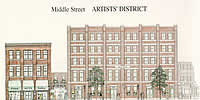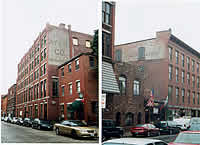Waste Site Cleanup & Reuse in New England
Ayer Lofts
Success in EPA Brownfields Assessment Grant Program
Lowell, MA
(August 21, 2003)
Contacts
The city of Lowell, MA utilized about $3,000 from EPA New England Brownfields Assessment Demonstration Pilot to conduct an Phase I environmental site assessment (ESA) at two adjacent brownfields sites in Lowell in 1996. The city of Lowell received this funding, as part of a $200,000 grant from EPA New England in 1996 to conduct environmental assessments at several sites throughout the city. The results from the ESA concluded that limited environmental cleanup was needed. In 1999, the city sent out a Request for Proposal (RFP) to cleanup and redevelop both properties. Private developer, Edward A. Fish Associates, Inc. of Boston, MA, cleaned up these sites and converted them to residential units, retail space for a café, and a gallery. The project was completed in spring of 2000.
The two brownfields sites were utilized most recently for commercial and industrial establishments between the 1840s and 1995. The 11,655 square feet property with two large brick buildings had been abandoned for an extended period of time. The properties are occupied by joined three-story (158 Middle Street) and four-story (172 Middle Street) brick buildings that span the entire footprint of the properties. The site is bounded by Middle Street to the north, an alleyway to the south, and attached brick buildings to the east and west.
The earliest recorded structures were three building at 172 Middle Street in 1841. One of these three buildings was utilized as the Eighth Grammar School. In 1872, the school moved to Merrimack Street and J.C. Ayer purchased the property and utilized the former school building as its office between 1879 and 1896. During the period of 1938 and 1939, a cosmetic manufacturer and MA Pharmaceutical Company moved into one of the buildings and remained on the premises through 1944. At that time, the Oxzyn Company obtained ownership of the property and remained there for an indeterminate period of time. Subsequent to the proprietorship, there followed periods of vacancy and occupancy by several light manufacturing companies.
A building structure was also present at 158 Middle Street prior to 1841. In the early1850's, the two buildings at the property belonged to Hezekiah Ashton (a gardener) and John Chamberlain (a wine and liquor merchant.) Between 1879 and 1896, “Lowell Steam & Gas Pipe Works” resided on the property as well as several other businesses in subsequent years, including a reed and harness manufacturer, a commercial printing establishment, and a brass foundry. Between 1890 and 1895, the current building was constructed. In 1917, a plumbing establishment occupied the building. In 1944, the Oxyzn Company occupied the building, as well as the adjacent 172 Middle Street building. In approximately 1979, the most recent occupants, a business called “Save-Mor Furniture,” moved into the building. In 1998, the city of Lowell retained ownership of both properties in tax title proceedings.
Compared to the rest of the state of Massachusetts, the city of Lowell is a low-income, minority community. According to the US 2000 Census, the city’s population was 105,167, compared to 6,349,097 in the state. Out of the total population, 4.2% of the city’s residents were African-American, 16.5% were Asian, and 14% were Hispanic or Latino. Comparing these high percentages of minority residents to the state as a whole, only 5.4% of the total state’s population was African-American, 3.8% were Asian, and 6.8% were Hispanic or Latino. The city’s 6.6% unemployment rate (out of the civilian work force) is higher than the state’s 4.6% unemployment rate. The medium household income in the city of Lowell is $39,192, compared to $50,502 at the state level. The number of families living below the poverty line in 1999 in the city of Lowell is 13.6%, compared to 6.7% of the families in the state as a whole.
According to the US 2000 Census Tract 3101, in which these properties are located, this part of the city is more economically disadvantaged and has a higher percentage of minorities living there overall. The population of this census tract was 3,881 people, and out of the total population, 10.9% were African-American, 8.4% were Asian, and 32.2% were Hispanic or Latino. The unemployment rate in this census tract is 13.1% (out of the civilian labor force) and the medium household income is $18,468. There were 259 families in 1999 (34.5%) who were living below the poverty line.
The ESA was completed by TRC of Lowell, MA and completed in November 1998. The results of the ESA showed that limited environmental cleanup was needed, including removing friable asbestos containing building materials, removing three 30-gallon chemical storage drums containing an oil lubricant and one 50-gallon drum containing carbon tetra-chloride (which were located in the basement of the 172 Middle Street property), and removing vermin and scat from sites.
In 1999, the city issued a RFP for both properties which was awarded to Edward A. Fish Associates, Inc. of Boston, MA for the bid price of $120,000 to redevelop the properties. The RFP included cleanup and redevelopment of the sites. The Boston firm invested an additional $3.9 million in the development of Ayer Lofts, 49 loft-style artist units (where artists can both live and work), as well as a 3,100 square foot café and gallery on the first floor. On average, the apartments sold for $175,000. The project helped increase the city’s tax revenue by $300,000 to $400,000 per year as a result of the redevelopment, which is valued at $9 million. The grand opening ceremony took place in the spring of 2000.



